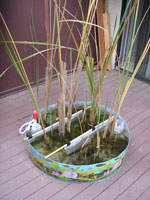
Arsenic-laced Drinking Water
Engineer builds inexpensive cattail treatment system in his backyard
- By Jared Brox
- Apr 24, 2009
 |
Photo courtesy of Jeremiah Jackson |
A casual phone conversation with his brother led engineer Jeremiah Jackson to develop an innovative arsenic filtration system that has the potential to improve the lives of millions of people worldwide affected by arsenic-contaminated drinking water.
Arsenic contamination affects more than 20 nations, including the United States, India, Bangladesh, Pakistan, Argentina, Chile, Mexico, and Taiwan. The World Health Organization (WHO) estimates that more than 35 million people in Asia alone are consuming arsenic-contaminated water with concentrations high enough to cause chronic illness and premature death.
Typical small-scale treatment processes include reverse osmosis, ion exchange, and activated alumina adsorption. Unfortunately, these approaches are technically sophisticated, require trained operators, and cost between $53 and $300 per 1,000 gallons of treated water. These requirements have limited their widespread use in rural and poor areas.
The need for a cheaper and easier technology prompted a senior engineer at Kleinfelder, a project management and engineering firm, to develop an innovative arsenic removal approach that uses inexpensive and sustainable natural processes to remove poisonous arsenic from drinking water.
"It all started in March 2002 with a phone call from my journalist brother," says Jeremiah Jackson, Ph.D., P.E., senior principal engineer for Kleinfelder. "He said he had been reading about this problem in India that involves arsenic contamination in the drinking water. It was funny; I think he assumed that because I'm an engineer, I should be able fix it.
"That night as I was lying in bed, I remembered that while doing my doctoral work I learned about certain aquatic plants that remove some metals from water," Jackson says. "And, because arsenic has a lot of the characteristics of metals, I thought maybe these plants could be used to filter drinking water. So, I called my brother back the next morning and shared my idea."
For the next few years, Jackson didn't put much serious thought into the arsenic contamination issue and, sadly, his brother passed away during that time. It wasn't until March 2005 that he revisited the idea of using aquatic plants to filter arsenic from drinking water.
"I finally had some free time I could devote to really thinking about how the process could work," Jackson says. "And I thought it would be a good way to honor my brother. After all, he was the one who brought the issue to my attention."
Drawing upon his initial research and past experience working with emerging nations through Kleinfelder's international office, Jackson developed a set of goals he felt must be met in order to present a realistic solution. First and foremost, he knew the design must be as simple as possible. An untrained individual should be able to assemble and operate the filtration system with minimal explanation. Also, because it would be used primarily in remote, rural areas, the system should not require a power source or plumbing. And, it should not depend on any foreign parts or technology. Everything needed to assemble the filtration system must be available domestically.
Keeping these guidelines in mind, Jackson started by setting up experiments in his backyard to test whether aquatic weeds could in fact remove arsenic from water. Because of its prevalence worldwide, he decided to focus on the common cattail. "I've learned through my travels that cattails are everywhere," Jackson says. "You can draw a picture of one and show it to a kid, and he knows what you are talking about."
Jackson placed cattail plants in a series of buckets containing sand and water with varying amounts of arsenic contamination and then tested the water over a period of time. Much to his satisfaction, he found that the cattails removed arsenic from the water surprisingly well. His next step was to build a full-scale prototype of the filtration system.
"Using water with arsenic levels typically found in India, I designed a system that would support a family of five," Jackson says. "My goal for the prototype was to be below the WHO's standard for arsenic levels in drinking water."
After analyzing data collected during his initial experiments, Jackson found that he only needed 12 square feet of space, about 4 feet in diameter, to treat enough water to support an average-sized family.
The prototype system was composed of ordinary household materials and was very simple to assemble. Jackson dug a small pond in his backyard, lined it with plastic sheeting and added sand. He then placed the cattails at one-foot intervals and used buckets to transport the water to the pond, similar to the way it would be done in the rural areas of countries such as India.
Operating the system is simply a matter of adding water to the system at the same rate it is being used. Jackson tested the prototype during a summer and winter season in San Diego, Calif., to see how it would be affected by changing weather conditions and experimented with adding small fish called gambusia, which are also common worldwide, to control the mosquito larvae population.
"The system worked better than I expected," Jackson says. "I discovered the cattail didn't necessarily treat the arsenic as a metal. Arsenic sits on the periodic table along the same lines as agricultural nutrients like nitrogen and phosphorous, and I found that because of this the plants would actually perk up as they absorbed the contaminated water."
Operation of the prototype system over an extended period resulted in an average arsenic removal rate of 89 percent, with an effluent
 |
Photo courtesy of Jeremiah Jackson |
arsenic concentration of 34 ug/L. WHO considers this water acceptable for long-term human consumption. The system is estimated to cost $0.21 per 1,000 gallons of treated water annually. The greatest expense associated with Jackson's prototype was a small $3 hand pump. Although the prototype was designed for single-family use, it is easily scalable to large-scale domestic and agricultural applications.
The process has been acclaimed and supported by key personnel at the Indian Institute of Technology, the American Society of Civil Engineers, and the Scripps Research Institute. And, because of the filtration system's potential to significantly improve the lives of millions of people affected by arsenic-contaminated water worldwide, Jackson has also been nominated for an award at the World Technology Summit in the health and medicine category.
"This whole experience has been incredibly rewarding," Jackson says. "This wasn't a project I was doing for work. I was doing it personally for my brother and because I knew I could do something that could potentially help a lot of people. It felt good."
About the Author
Jared Brox is a writer with Two Rivers Marketing, Des Moines, Iowa.